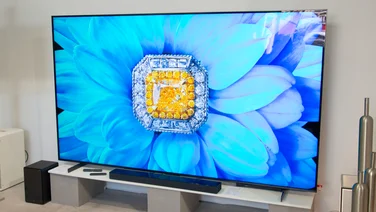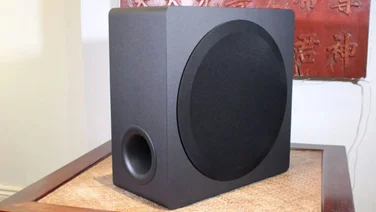To help us provide you with free impartial advice, we may earn a commission if you buy through links on our site. Learn more




For this review we tested the 42in model in the 5008T range, but it’s also available in 32in (32PFL5008T), 47in (47PFL5008T) and 50in (50PFL5008T) screen sizes. All models have identical specifications except for their dimensions and power usage. We’re confident that image quality will be practically identical across the range.
We’ve been impressed with Philips’ 2013 range of LCD TVs, so we had high hopes for the rest of the series. The 42PFL5008T/12 is one of Philips’ more entry-level LCD sets, but this 42in smart TV is anything but budget. It follows the same radical design as the rest of this year’s models, with its super thin metal stand and slim, almost non-existent bezel. It certainly makes an impression and looks much smarter and stylish than we’d expect at this price.

It also comes with Ambilight LEDs that run down the left and right edges of the panel. These can either show a static white light to illuminate the wall behind the set, or match the colour of what’s being shown onscreen so the picture feels like it extends outside of the TV’s bezel. It’s a neat touch that really comes alive when the lights are turned off, and we found its gradual blend of different colours helped immerse us in what we were watching. You can easily switch Ambilight off if you find it too distracting, but it’s yet another unusual feature that sets the 42PFL5008T apart from the crowd.
SMART TV, NETWORKING AND PORTS
Unlike other TVs, you’re not immediately presented with Philips’ Smart TV hub when you first turn it on either. Instead, you’ll have to access it through the remote once you’ve connected your TV to your network via Ethernet or its integrated Wi-Fi. While the hub’s design is quite basic, it’s functional and easy to navigate. Popular apps like Netflix, Facebook, Twitter, YouTube and a web browser are given pride of place on the front page below a live feed of your selected source, but you’ll have to root through its App Gallery to find other favourites like BBC iPlayer. This isn’t too much of a problem, though, as apps can be moved and repositioned on the home screen to your liking, so you’ll only have to find them once.

There’s also a store to download more apps. It’s a much better selection of apps than when we reviewed the PFL6008S, but at the time of writing, promised apps such as LoveFilm, 4OD, ITV Player and Demand 5 are still yet to appear. We’ve been told to expect them in later in the year, but this slow introduction rather puts the PFL5008T on the back foot compared to Samsung’s 2013 TV range, which comes with most of these as standard.
On the back panel, you’ll find a wide range of inputs, including three HDMI inputs (one of which supports ARC, so you can send sound back to an amp), SCART, component and composite inputs, a Common Interface slot, a 3.5mm headphone jack and digital optical audio. There are also two USB ports for connecting an external flash drive.

This can be used to record programmes or play your own media files (USB and streaming over the network using DLNA are supported) and its format support was excellent. We were able to play all of our video files. Audio support was equally as impressive. The TV didn’t recognise our FLAC files, but it played everything else without any problem. Image file support was also more wide-ranging than other smart TVs, as we could see our BMP, JPG, PNG and GIF images. The only image format it didn’t pick up was our TIFF file.
PICTURE QUALITY
The 42PFL5008T’s most impressive feature, though, was its outstanding picture quality. Standard definition content looked great on its 42in panel, and while there was still quite a lot of noise and artefacts present, particularly in lower-quality channels like BBC News, most channels upscaled very nicely.
Colours were bright and vivid, but there’s plenty of scope for adjusting the picture. The only slight hindrance is that finding the image settings is rather less intuitive than other smart TVs. Instead of simply being able to press the Options button, which only lets you change the preset picture mode, you have to press the Home button on the remote, go into the Setup menu where you’ll finally find the TV settings. It’s a rather convoluted route to something that should be at the tip of your fingers, but at least you’re presented with lots of options when you get there.

We found that the Personal picture mode produced the most accurate colours as Vivid, Photo and Energy Saving were far too lurid, and Movie was a little too warm for normal TV, but all of them can be customised using the backlight, colour saturation, sharpness, tint, gamma, brightness and contrast settings. There are also separate noise and artefact reduction settings, an auto brightness setting that will adjust to your room’s lighting conditions, advanced sharpness, dynamic contrast, dynamic backlight and custom colour temperature options. Its noise reduction setting can be a little strong, though, as anything higher than its minimum setting created a glossy haze across the screen.
Full HD content was far more impressive, although we still needed to do quite a bit of fine-tuning to get the best picture quality. In our Blu-Ray test footage of Star Trek, we had to drop the backlight setting quite considerably to deepen the 42PFL5008T’s fairly average black levels, and we also found its dynamic contrast setting useful when trying to improve the contrast. We’re not normally fans of dynamic contrast as it often makes films appear far too sharp and harsh, but here we were pleased to see it significantly increased the level of detail in night scenes without losing its superb colour accuracy.
We were a little disappointed there wasn’t any frame interpolation options, but thankfully the 42PFL5008T’s 300Hz panel handled fast moving action sequences well. There was still a little bit of juddery camera movement during fast pans across the screen, but it wasn’t enough to detract from our viewing experience.
3D AND AUDIO QUALITY
It handled 3D content very well, too. It uses passive 3D so you don’t have to charge your glasses or change batteries, and it comes with two pairs in the box. The glasses aren’t too dark either, so colours remained rich and vivid throughout our test footage of Avatar. The depth of field was also impressive, but you’ll have to make sure you’re sitting directly in front of the TV while watching 3D films, as we did notice a very small amount of crosstalk when viewing from the side.
Dedicated 3D options are quite thin on the ground, but all the regular 2D picture settings are available here to make sure you can get a good picture. As with Star Trek, we found its dynamic contrast helped pack a lot more detail onto the screen without oversaturating the colours, and we didn’t lament the lack of frame interpolation here either despite the occasional judder.
The 42PFL5008T’s sound quality was fairly average. There was plenty of volume and a good level of bass, but it was a little tinny overall. To get the best audio experience, we’d recommend a sound bar or a dedicated sound system.
CONCLUSION
The Philips 42PFL5008T is an outstanding TV with extensive picture settings, but its lack of frame interpolation and smart TV features mean that the LG 42LA690V just beats it to the Best Buy award.






